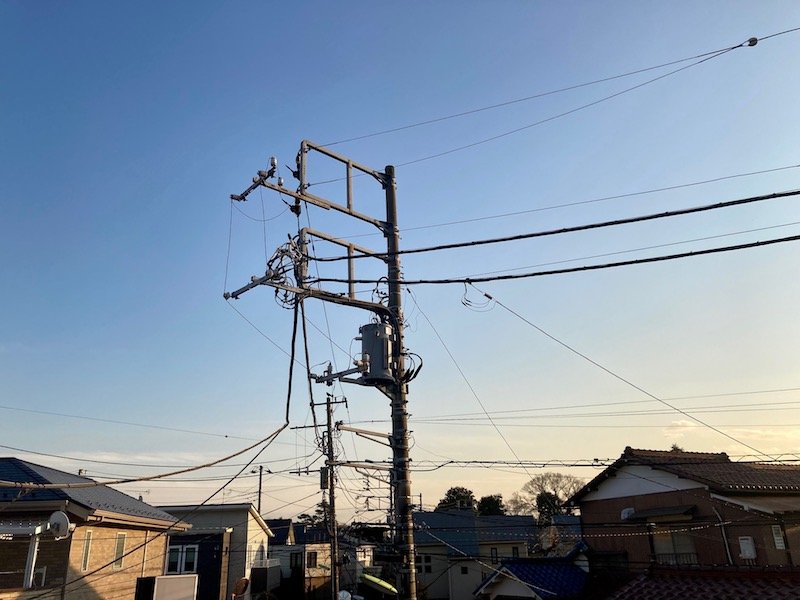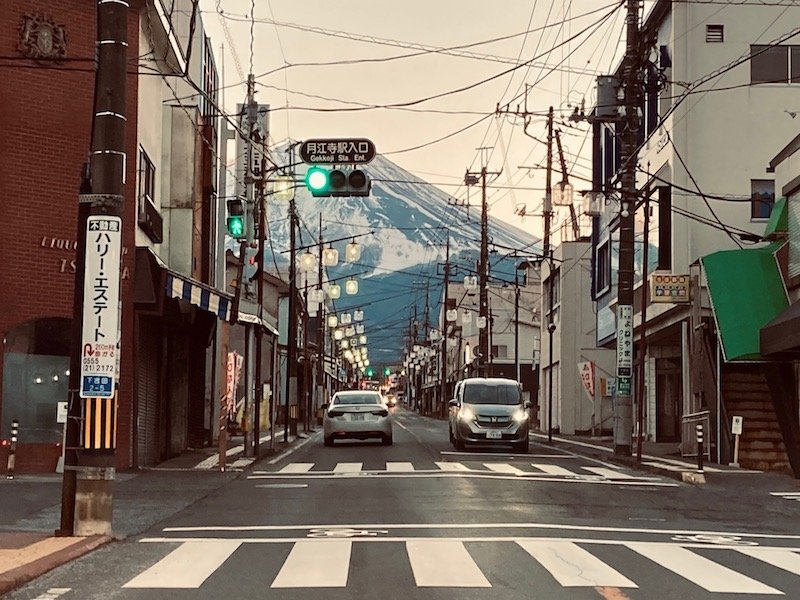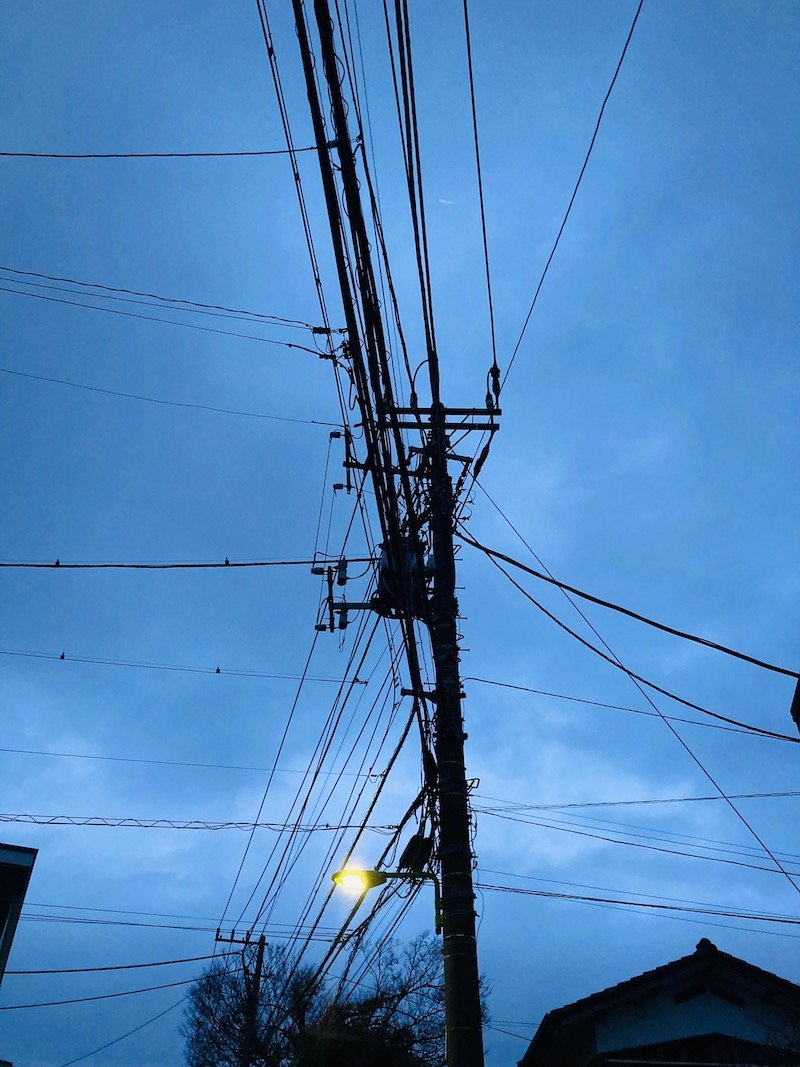2023 | 5 min read
As the saying doesn’t go: when a man is tired of utility poles, he is tired of Tokyo. From signifier of modernity to ugly ubiquity, from strange comfort to international embarrassment, the utility pole is a staple of the Tokyo streetscape. There could be as many as a million poles in Tokyo – nobody is really sure. Despite occasional calls for their removal, utility poles have stood the test of time thanks to a unique survival mechanism: they’ve managed to make themselves invisible to most Tokyoites.
How do I know? Even the pole that was nearest and dearest to me managed to give me the slip. I was trying to recall from memory the view from my balcony when I completely forgot about the utility pole standing right in front of the building. This is no ordinary utility pole either. None of them are, if you look closely enough. This beast is four storeys high and has five branches, some of them double-pronged. As I studied it properly for the first time, I learned something new. Even though they were placed every few metres across the city, I hadn’t actually “seen” a utility pole for years.

What got me seeing utility poles again was art. Tokyo has many small museums that aren’t afraid to cover niche subjects. One recent exhibition at Nerima Art Museum was all about the history of electrical wires and utility poles in Japanese painting. Artists of the late 19th and early 20th centuries went to great lengths to include utility poles in their landscapes. Not unlike heads bent over smartphones today, utility poles in the Meiji era were an irresistible motif for the changing times.
But at some point in the 20th century, people stopped seeing utility poles. They had vanished into the environmental background of Tokyo. Akira Yamaguchi is not the only contemporary artist to place utility poles in incongruous pre-modern landscapes as a way of making us notice them again. Visitors might also remark on the poles and point out the aesthetic interest, but such enlightened observations would only baffle a Tokyoite. Because Tokyo has utility poles like other cities have dogshit or wheelie bins: things you don’t really notice until you walk, step or fall into them.
Over the years, there have been various campaigns to force Tokyo to bury more of its utility lines underground. The current burial rate, in case you’re keeping score, is less than 10%. These well-meaning campaigns are usually aimed at beautifying the city in the eyes of foreign visitors. This is probably why they receive almost no local support. There’s even an argument that says residents are comforted by the poles. One Japanese blogger writes: “Places with power lines are always places where you’ll find people living their lives. In some ways, you may even think of them as being like blood vessels. They show that a person or village is alive.”

Removing utility poles would change the landscape in fundamental ways. It would also destroy a subculture of aesthetic appreciation. The main street of Fujiyoshida, a small city in Yamanashi prefecture, has become internet-famous for its views of Mount Fuji behind a tangle of overhead cables. Recently I made the short trip to Fujiyoshida to interview a local artist. When I floated the suggestion that some project or other could be based on the utility poles, he returned a blank expression as if to say: what poles?
Up close, the protective surface of a utility pole is one of those rare spaces in Tokyo that is genuinely felt to be public property. Who owns the poles? Nobody knows or cares to find out. While getting permission to use a public noticeboard might entail a visit to so-and-so-san of the such-and-such-kai, a utility pole requires no such neighbourly caution, making it the perfect place to display news of your missing Mississippi Tortoise.

But the main argument for keeping utility poles is disaster resilience. Overhead electrical lines are easier to access and repair in the event of an earthquake, even if there’s an argument that says they’re also more likely to suffer damage. Residents of high-decibel cities could point to another benefit of the poles. Burying utility lines underground means trading the quickly-forgotten convenience of no longer having to see them for the ongoing inconvenience of men digging up the road.
When repairs are needed in Tokyo, men arrive in clean yet crumpled uniforms with helmets and safety hooks, scale a pole, perform electrical surgery, and are gone within an hour. It’s useless to offer them tea or remark on a job well done as this would offend their professional dignity. These utility men behave at all times as though they’ve dedicated their lives to one noble task: keeping every building in Tokyo connected to the grid and making life safe, comfortable and convenient for all.

It would never occur to a utility man to take time off work to pursue some personal dream like entering a poker tournament in Las Vegas or writing a children’s book about a talking utility pole. Given their resemblance to members of Yellow Magic Orchestra, I can imagine some of these men playing with vintage Roland synthesisers at home, but only on Sundays. A utility man’s one professional whimsy is to drive around in a platform-hoist truck with a giraffe-print design. But this is only to delight children – he never seriously pretends to be a giraffe.
While making love with your partner in an apartment in Tokyo, if you should look up and see one of these men hanging outside the window, observe how diligently he attends to his pole. He will never look your way, bark like a dog, stick out his tongue, or take pictures with his phone. He models a kind of seriousness that is in some ways my total opposite, which helps to explain the admiration I feel.
While he’s keeping the city running, I’m thinking of starting a band called Utility and the Poles. I imagine myself as the frontman, Utility, before noting that I lack the necessary charisma. I’d be happier as one of the Poles. I don’t know yet which instrument I’ll play, but there’ll definitely be a synthesiser or two. We’ll all wear uniforms purchased from Workman and we won’t move around much on stage. Our shows will be free to attend, but we’ll bill you at the end of the month.
Ideas like these should be gently entertained and just as gently discarded. The city makes space for all kinds of dreaming, because it meets all of our basic needs. Utility poles don’t just bring peace of mind. Utility poles set the mind free. To exercise your mind or to have an idea, look around for what’s hiding in plain sight. Find your utility poles.

Next: Murakami Library
